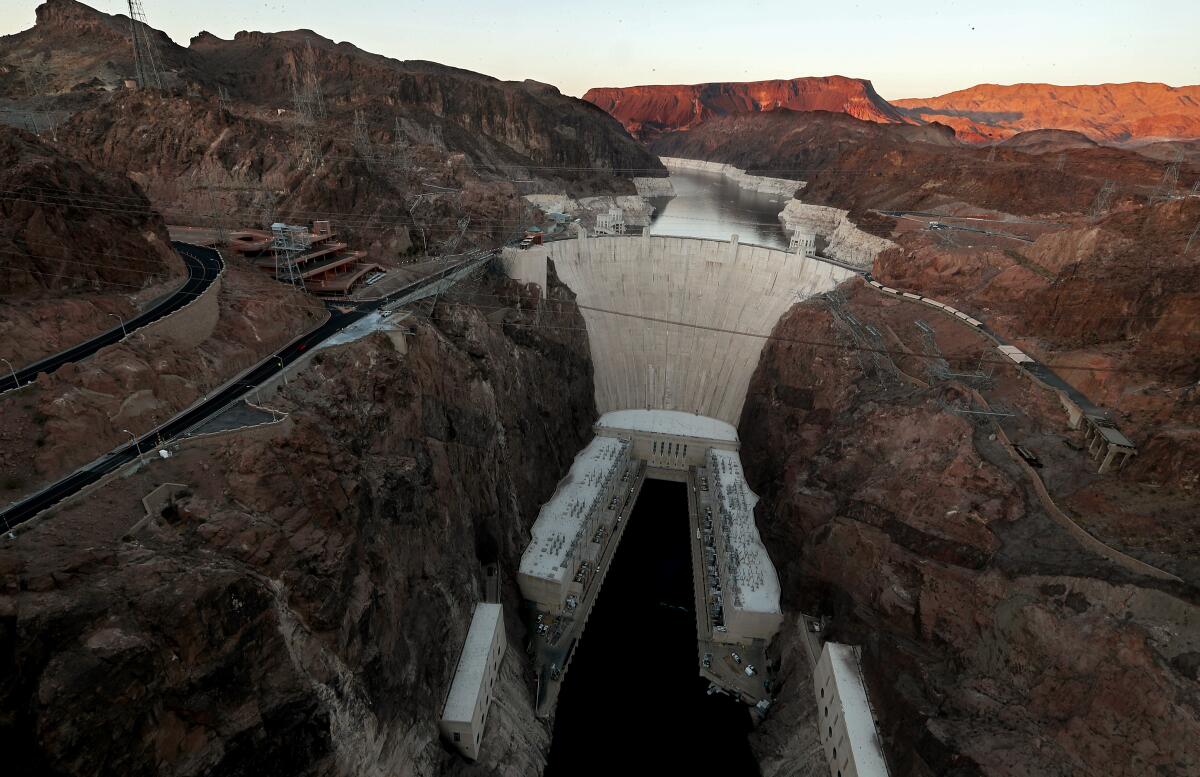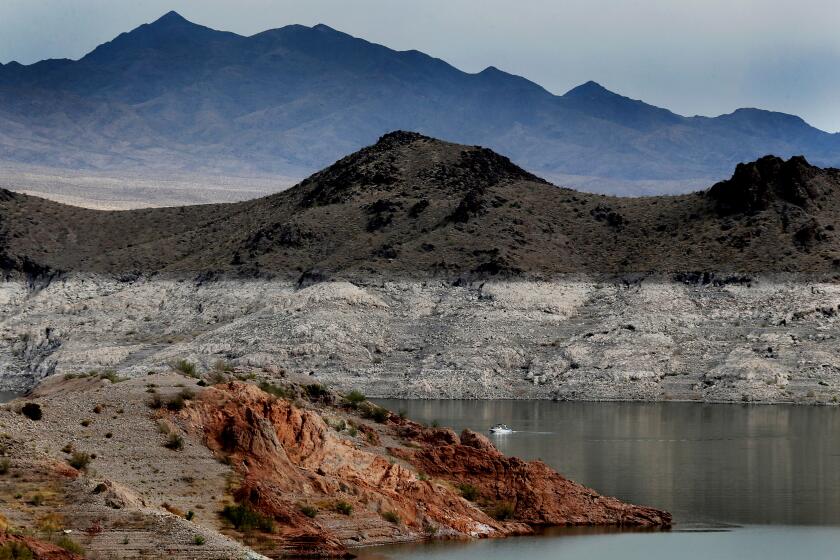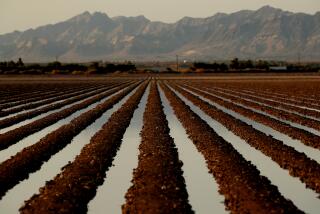As talks on Colorado River water falter, U.S. government imposes new restrictions

- Share via
After Colorado River Basin states failed to meet a deadline for emergency drought reductions Tuesday, the U.S. Bureau of Reclamation announced new emergency water cuts for Arizona, Nevada and Mexico as the nation’s two largest reservoirs decline to perilously low levels.
The seven states that rely on Colorado River water were told two months ago to develop plans to drastically reduce water use by 2 million to 4 million acre-feet, but those talks have grown acrimonious. At a news conference Tuesday, federal officials said that an agreement was urgently needed and that it was declaring a Tier 2 shortage for next year — a historic first for the shrinking river.
“In order to avoid a catastrophic collapse of the Colorado River System and a future of uncertainty and conflict, water use in the basin must be reduced,” said Tanya Trujillo, the Interior Department’s assistant secretary for water and science.
Under Tier 2 shortage conditions, Arizona’s annual water apportionment will be reduced by 21%, Nevada’s by 8% and Mexico’s by 7%. There is no required water savings contribution for California.
As Lake Mead shrinks after almost two decades of severe drought, accumulated items on the lakebed are being exposed.
“The risks that we see to the system are based on the best available science that we’ve seen — and those risks have not changed. So today we’re starting the process and more information will follow as far as the actions we’ll take in that process,” said Bureau of Reclamation Commissioner Camille Calimlim Touton.
The river’s two main reservoirs — Lake Mead and Lake Powell — are now nearly three-fourths empty and are projected to continue dropping. As a result, the Biden administration ordered states to come up with a plan that would decrease the total amount of water diverted by roughly 15% to 30%.
The absence of an agreement among the states now raises the risk that the Colorado River crisis — brought on by chronic overuse, global warming and the West’s drying climate — could spiral into a legal morass. At the same time, Interior Department officials have warned they are prepared to impose cuts if necessary to protect reservoir levels.
When asked by reporters Tuesday if the federal government was poised to order more unilateral cuts, Touton said, “I want to continue to push on the need for partnership in the basin and the need for collaboration and finding a consensus solution, not just for next year, but for the future.”
Those involved in the negotiations say there have been difficult discussions among the states and among urban and agricultural water districts. There have also been growing tensions among the states of the river’s Lower Basin — California, Arizona and Nevada — and those of the Upper Basin — Colorado, Wyoming, New Mexico and Utah.
Recurring drought and rising temperatures have already begun to alter the landscape of California and the American Southwest, researchers warn.
Deputy Secretary of the Interior Tommy Beaudreau told reporters that the federal government would continue working with the states to develop a consensus solution.
“As dire as the situation is, there are reasons for encouragement,” he said. “While there remains work to be done, the states have come together to try to hammer out voluntary solutions. This is a complex environment.”
Tensions remain high among the states, however, as Arizona and Nevada have already endured a previous round of water reductions. They say other states need to do more.
On Tuesday, U.S. Sen. Mark Kelly (D-Arizona) sent a letter to Secretary of the Interior Deb Haaland, arguing that farmers, major cities and tribes in his state have already reduced their water use at a pace and scale greater than other states in the basin.
“Arizona has offered to put more wet water on the table than any other state, while other parties have offered a fraction of the same amount,” Kelly wrote.
That sentiment was echoed in a joint statement from Tom Buschatzke, director of the Arizona Department of Water Resources, and Ted Cooke, general manager of the Central Arizona Project: “It is unacceptable for Arizona to continue to carry a disproportionate burden of reductions for the benefit of others who have not contributed.”
In California meanwhile, the Imperial Irrigation District — which controls roughly one-fifth of all Colorado River water rights — and the Metropolitan Water District of Southern California released statements saying they would continue to work toward a collaborative solution.
The MWD — which supplies drinking water for 19 million people — said it appreciated the “limited extension” federal officials had granted them to try and reach an agreement and warned water users to brace for permanently reduced supplies.
“As these discussions continue, we urgently call on everyone who relies on Colorado River water, including communities across Southern California, to prepare for reduced supplies from this source, permanently,” wrote MWD General Manager Adel Hagekhalil. “This is not simply a drought that will end, allowing reservoir levels to recover on their own — this is a drying of the Colorado River Basin. We are all going to have to live with less. Working together, we know we can meet that challenge.”
A nuclear conflict involving less than 3% of the world’s stockpiles could kill a third of the world’s population within two years, researchers say.
The water reductions announced Tuesday were agreed to by the Colorado River Basin states under a 2019 agreement, known as the Drought Contingency Plan, while Mexico’s water cuts are governed by a separate binational pact. Though California avoided water curtailments, if reservoir levels continue to decline, it could be next in line to reduce its consumption.
The ominous reservoir projections and multistate water impasse have underscored the importance of investments in drought resilience and water management. Tuesday, President Biden signed the sweeping Inflation Reduction Act, which includes $4 billion in funding for water management and conservation efforts in the Colorado River Basin and other areas experiencing similar drought conditions.
Much of that money is expected to be used to pay farmers and others to voluntarily use less water. Under one proposal offered by Arizona farmers, participating growers would forgo 1 acre-foot of water for each acre of farmland, generating roughly 925,000 acre-feet of savings.
Last November, Biden signed the Infrastructure Investment and Jobs Act, which allocates $8.3 billion to address drought-related challenges in western water and power infrastructure.
On Tuesday, environmental groups voiced frustration over the lack of progress by state leaders and water managers, and also called on Upper Basin states to make voluntary sacrifices for the greater good of the watershed.
“I think the bureau created a space for folks to come together to sit around a table and hash out a deal like adults,” said Kyle Roerink, executive director of the Great Basin Water Network. “But from everything that I’m hearing … it’s like the kids are not playing well in the sandbox together. And we always hear about these notions of everybody singing Kumbaya and the collaboration is so wonderful and so great. How many times have we heard that, but really what’s happening is they’re sharpening their knives?”
Roerink and others said they worry that that without an agreement, the matter will become mired in lawsuits and lengthy court battles.
“I think everybody is preparing for the worst as it relates to their own interest, but they’re not necessarily preparing for the worst as it relates to the interest of the river,” Roerink said.
As reductions are sought from agriculture and municipal systems, some activists urged regulators to reexamine the way in which the tourism and recreation industries use water.
“We also need to address the fact that, for instance, in the Coachella Valley, there’s at least 124 golf courses that I can account for, countless water parks and then there’s the Disney operations there that have their own lagoons and lakes,” said Robin Silver, a co-founder of the Center for Biological Diversity.
“This is the desert. It’s time to grow up.”
Times staff writer Ian James contributed to this report.










